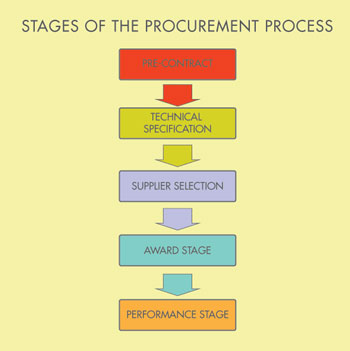Facility Managers Must Effectively Manage Contract Transition
First of a 5-part article on making outsourcing changes and transactions run smoothly

Some senior real estate executives have reported that outsourcing will continue to increase at a steady rate. In a 2015 Building Operating Management survey of almost 2,000 facility managers, 20 percent reported that they expect outsourcing to increase this year, which follows 17 percent reporting an increase in the last year. The continuing growth in outsourcing — which will increase the number of facility management service-provider changes and transactions — will make it even more important to have sound business transition processes in place. With a large percentage of a facility management budget locked into a service contract, or multiple service contracts, it is critical to get the contracts running properly from the start, which depends on a smooth transition. A smooth contract transition depends on having a good transition plan, and this article will address four key steps.
A good transition plan involves employing facility management contract transition management (CTM). CTM is the plan for transitioning from one model of facility management service delivery to another.
Having a transition plan is important because changing from one service provider to another, or transitioning from internally provided services to an outsourced contract, can be overwhelming due to the number of details, the expense, and the sometimes emotional process. Unfortunately, many transitions fail. That can leave the owner and facility manager in an undesirable relationship for years, while a service provider can discover it has committed to a contract that could damage it financially and possibly harm its professional reputation.
In addition, the risks of not adopting a successful CTM plan include a repetition of past mistakes, failure to ensure a strong win/win contract for both the provider and facility manager, productivity issues for the facility manager’s customers on the affected sites, and damage to the equipment due to lack of maintenance.
A comprehensive CTM plan should address infrastructure and technology (e.g., CMMS/IWMS), processes (e.g., evaluation and monitoring), communication, collaboration, and people, which involves change management, clarification of roles, and responsibilities. Successful CTM requires careful forethought, planning, and a systematic approach to managing the transition, the risks, and the change.
Paying attention to four key areas can help ensure a successful transition. Read on for a discussion of each area.
Teena Shouse, CFM, IFMA Fellow, is vice president of corporate services at Facility Engineering Associates. She has over 26 years of experience in service-related fields, mainly facility management. She can be reached at teena.shouse@feapc.com.
Why Some Service Contract Transitions Fail
Most of the time failure occurs because both parties did not do the necessary due diligence and just hoped for the best. In the end, there is finger pointing, when in reality it was perhaps just a combination of several things including lack of coordination between procurement and the business unit, weak program scope, lack of due diligence in understanding full client expectations, etc.
A successful transition takes time. The actual time varies according to the complexity of the contract and affected facilities, and the number of services involved. Even for very simple conversions to be successful, at least four to five months are needed.
Successful transitions also take money. For a contract transition management project, transition costs can range from $10,000 for a transition period of 30 days to $300,000 for six months. It is essential to have clear transition expectations, as well as the time and the funding necessary to achieve those expectations.
Finally, a successful transition requires a well-developed risk management plan. Identifying the potential issues, the likelihood that an unwanted event may occur, and the effects it will have on the transition process allows everyone to be prepared. A classic risk, particularly in government contracts, is a bid protest, which will delay the award of the new contract. Recognizing this as a possibility and planning for the time it will add to the process is key to a smooth transition.
— Teena Shouse
Related Topics:
















